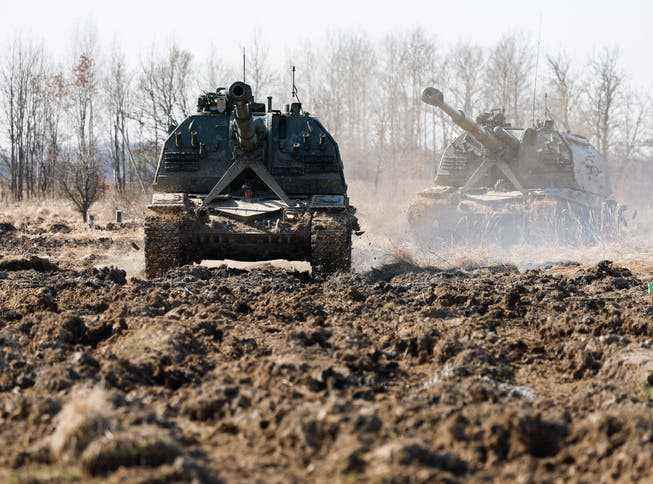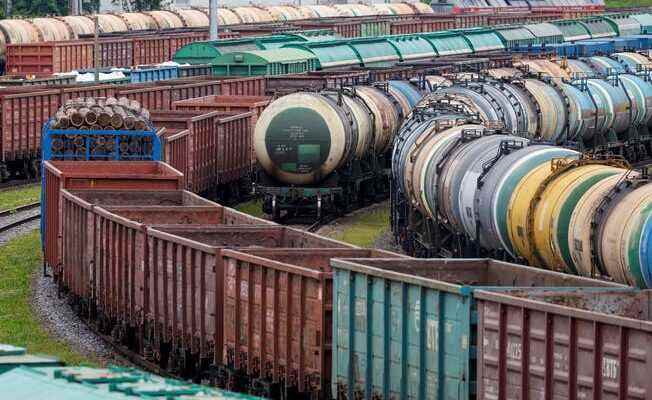After the Lithuanian restriction of rail transit to the Russian exclave, Moscow is seething. The strategically important area on the Baltic Sea is severely affected by the sanctions. The crisis with Lithuania makes agitators rejoice.
Transporting goods with freight trains like these in Kaliningrad will become very difficult in transit across EU territory in the future.
Russian rhetoric towards Lithuania is becoming more and more strident. If Russia classifies an attitude as “hostile”, it is already too late for talks, said the spokeswoman for the Russian foreign ministry. That should probably mean: There are no compromises, only the fulfillment of the requirements is an option – or tough countermeasures. The decision by the Baltic state to stop handling goods subject to European sanctions against Russia struck a chord in Russia.
It is about rail transit traffic between Russia and its Kaliningrad region on the Baltic Sea, which is completely surrounded by European Union Member States: Poland to the south and Lithuania to the north. The rail connection via Belarus and Lithuania is a lifeline for the exclave. The governor of the region, Anton Alikhanov, fears that up to 50 percent of the transports processed via this route could be affected.
risk of escalation
The dispute is far more than a regional posse. It has the potential to add dangerous strains to the already strained relations between Russia and the West. For Moscow, it is about securing its strategically important western outpost and also about principle. The case shows that the West has completely gambled away its credibility, Kremlin spokesman Dmitry Peskov said indignantly. It is about a “violation of everything and everyone”. This refers to the legal agreements that Lithuania made with Russia on transit traffic when it joined NATO and the EU.
For some agitators in Moscow, the situation comes at just the right time. Since Russia’s attack on Ukraine, they have been speculating on prime-time television about how the crisis in the European security order could be used to create a corridor between Belarus and Kaliningrad. That would bring Russia not only indirectly, as in Ukraine, but quite directly into a confrontation with NATO. But the question would then be which military – such as nuclear – threats the alliance would be able to withstand.
Such daring ambitions dwindled in the face of Russia’s lack of rapid successes in Ukraine. But Russia was happy to accept the Lithuanian through ball. After the Lithuanian chargé d’affaires on Monday, the Ministry of Foreign Affairs also called on the European Union ambassador in Moscow to immediately fully restore transit traffic through Lithuania. Otherwise there will be severe consequences.
The Secretary of the Security Council, Nikolai Patrushev, one of the masterminds of the war against Ukraine, even traveled to Kaliningrad for a special session of his body with regional leaders. He threatened drastic measures that would hit Lithuania’s population hard. Martial tones as they come out Votes of particularly aggressive MPs at the beginning of the week were put into perspective. Lithuania’s exports via Russia and the power supply jointly organized by Russia, Belarus and the three Baltic states could be the target of Russian retaliatory measures.
Military outpost
Kaliningrad is of strategic and symbolic importance for Russia: strategic because of its location as a “lookout” in the west and as an ice-free port, symbolically as a territorial trophy from the Second World War with intellectual and historical significance for Germany – Königsberg, as Kaliningrad was called until 1946, is a place of activity Immanuel Kant and other great minds a special German place of remembrance.

Because of the strategic importance of Kaliningrad, Russia conducts a large number of military maneuvers there. The picture shows an artillery exercise in March.
Highly armed militarily during the Cold War, after the collapse of the Soviet Union, the area temporarily turned into a “black hole” in north-east central Europe as a Russian exclave. High-flying economic plans missed their target, but until the east-west rift in 2014 the region developed into an interesting business location, for example for foreign car manufacturers.
Since then, militarization has slowly increased again. In 2018, after much back and forth, Russia admitted that it had moved Iskander short-range missiles, which can be equipped with nuclear weapons, to the region. You could theoretically reach Berlin.
Large parts north of the city of Kaliningrad are a restricted military area. The concern of not being able to defend the territory in an emergency due to the lack of land connections has always been a concern for the army and leadership. This became particularly acute during the protests in Belarus in 2020/21, when Moscow had to fear at times that the western neighboring country, which is important for transit, could come under Western influence.
Kaliningrad was particularly hard hit by the sanctions because of its exposed location. The rail connections to Poland and Lithuania are severely restricted due to tightened controls, the worldwide The port is hit hard by the logistics crisis. Accordingly, compared to other parts of Russia, inflation rose to record levels. The car factories lack components from abroad, and the construction industry lacks building materials.
When Governor Alikhanov recently tried to explain the slowdown in construction activity to President Putin as the consequences of the “military special operation” in Ukraine, the latter cut him off harshly: everything was homemade, he snapped at him; the “military operation” had nothing to do with it at all. The dispute with Lithuania shows that things are not that simple.
